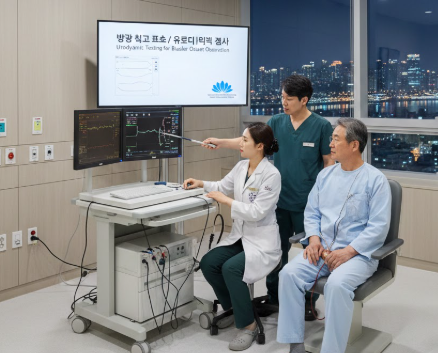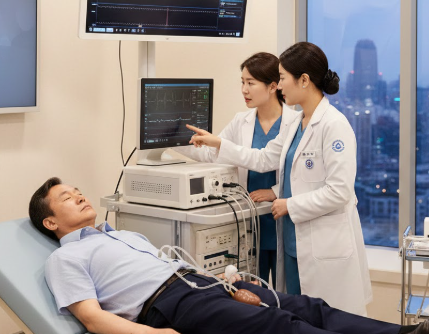Treatment Overview
Advanced Laparoscopic Ovarian Cyst Removal in Korea is a cutting-edge minimally invasive surgical procedure designed to treat ovarian cysts with precision, minimal discomfort, and rapid recovery. Korea is renowned for its advanced gynecologic surgical techniques, combining state-of-the-art laparoscopic technology with highly skilled surgeons to deliver safe, effective, and fertility-preserving ovarian cyst removal.
Ovarian cysts — fluid-filled sacs that develop on or within an ovary — are a common gynecologic condition affecting women of all ages. While many cysts are benign and resolve naturally, some require surgical intervention due to size, symptoms, or suspicion of malignancy. Laparoscopic cystectomy in Korea offers a safe solution, preserving ovarian function while minimizing invasiveness and recovery time.
Leading Korean hospitals such as Samsung Medical Center, Asan Medical Center, Severance Hospital, CHA Bundang Women’s Hospital, and Ewha Womans University Mokdong Hospital specialize in advanced laparoscopic ovarian cyst removal. These centers combine high-resolution imaging, minimally invasive techniques, and multidisciplinary expertise for optimal patient outcomes.
Purpose & Benefits
The primary purpose of advanced laparoscopic ovarian cyst removal is to safely excise cysts while preserving ovarian tissue, maintaining hormonal balance, and protecting fertility. The approach offers significant advantages over traditional open surgery.
Key benefits include:
- Minimally Invasive Surgery: Small incisions result in less pain, quicker recovery, and minimal scarring.
- Fertility Preservation: Carefully preserves healthy ovarian tissue to maintain reproductive potential.
- Enhanced Visualization: High-definition laparoscopic cameras provide magnified views of ovarian structures.
- Reduced Risk of Complications: Minimally invasive techniques reduce bleeding, adhesions, and infection risk.
- Short Hospital Stay: Many patients return home within 24–48 hours.
- Faster Recovery: Most patients resume normal activities within 1–2 weeks.
- Comprehensive Treatment: Allows simultaneous diagnosis and treatment of related pelvic conditions.
Korea’s advanced laparoscopic programs integrate innovative surgical methods with patient-centered care to ensure the best possible outcomes.
Ideal Candidates
Advanced laparoscopic ovarian cyst removal is suitable for women diagnosed with ovarian cysts requiring surgical intervention. Ideal candidates include:
- Women with symptomatic ovarian cysts causing pelvic pain, bloating, or menstrual irregularities.
- Patients with large or persistent cysts that do not resolve with observation.
- Women with cysts suspected of containing abnormal or malignant tissue.
- Patients desiring fertility preservation.
- Women seeking minimally invasive surgery with faster recovery.
Preoperative assessment in Korea typically includes transvaginal ultrasound, MRI, hormone level testing, and blood work to ensure precise diagnosis and surgical planning.
Possible Risks & Complications
While advanced laparoscopic ovarian cyst removal is safe and minimally invasive, patients should be aware of possible risks:
- Bleeding: Rare, though possible during removal of large or vascular cysts.
- Infection: Low risk due to sterile surgical technique.
- Adhesion Formation: Reduced compared to open surgery but possible.
- Damage to Surrounding Structures: Rare but possible, especially with complex cysts.
- Recurrence: Ovarian cysts may reoccur depending on underlying causes.
Korean hospitals mitigate these risks through advanced surgical tools, expert surgeons, and careful postoperative monitoring.
Techniques Used
Advanced laparoscopic ovarian cyst removal in Korea employs sophisticated methods to ensure safety and precision:
- High-Definition Laparoscopy: Provides clear visualization for precise dissection.
- Microsurgical Instruments: Allow meticulous cyst removal while preserving healthy ovarian tissue.
- Energy-Based Devices: Reduce bleeding and minimize tissue trauma.
- Single-Port or Multi-Port Access: Customized approach based on cyst size, location, and patient preference.
- Intraoperative Imaging: Ensures accurate cyst removal and assessment of surrounding structures.
These techniques ensure a targeted, fertility-preserving approach to ovarian cyst treatment.
Recovery & Aftercare
Recovery from advanced laparoscopic ovarian cyst removal is generally faster than traditional surgery, with most patients resuming normal activities within one to two weeks.
Aftercare in Korea includes:
- Postoperative monitoring for healing and early detection of complications.
- Pain management tailored to the patient’s needs.
- Advice on diet, physical activity, and hormonal balance.
- Follow-up ultrasound to ensure complete removal and monitor ovarian health.
- Fertility counseling for women planning pregnancy.
Korean hospitals emphasize structured aftercare to support recovery, fertility, and overall reproductive health.
Results & Longevity
Advanced laparoscopic ovarian cyst removal delivers long-term relief from symptoms while preserving ovarian function. Korean hospitals report high success rates, minimal complications, and strong patient satisfaction.
Long-term benefits include normalized menstrual cycles, reduced pelvic discomfort, improved fertility potential, and a high quality of life. With proper follow-up and lifestyle management, recurrence rates can be minimized, ensuring lasting results.
Treatment Process in Korea
- Consultation: Comprehensive evaluation of symptoms, imaging results, and medical history.
- Preoperative Planning: Tailored surgical strategy based on cyst type, size, and patient needs.
- Surgical Procedure: Advanced laparoscopic ovarian cystectomy using high-definition imaging and precision instruments.
- Recovery: Short hospital stay and structured postoperative care.
- Follow-Up: Imaging and consultations to monitor healing and ovarian function.
Korean hospitals ensure the treatment process is patient-centered, efficient, and safe.
Cost Range
The cost of advanced laparoscopic ovarian cyst removal in Korea varies depending on cyst complexity and hospital reputation:
- Standard Laparoscopic Cystectomy: ₩4,000,000 – ₩7,000,000 KRW ($3,000 – $5,200 USD)
- Advanced or Robotic-Assisted Laparoscopic Cystectomy: ₩8,000,000 – ₩12,000,000 KRW ($6,000 – $9,000 USD)
These prices reflect Korea’s advanced surgical expertise, cutting-edge technology, and patient-focused approach.
Popular Clinics for Advanced Laparoscopic Ovarian Cyst Removal in Korea
- Samsung Medical Center – Experts in advanced laparoscopic gynecologic surgery.
- Asan Medical Center – Pioneers in fertility-preserving cystectomy.
- Severance Hospital – Known for precision minimally invasive surgery.
- CHA Bundang Women’s Hospital – Specialists in personalized ovarian cyst treatment.
- Ewha Womans University Mokdong Hospital – Combines advanced technology with holistic patient care.




